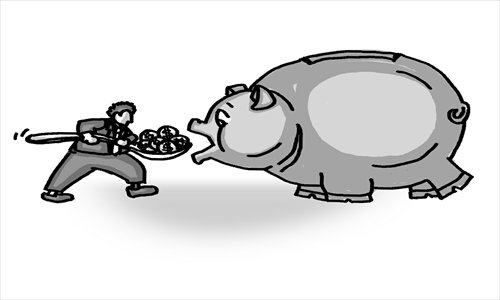HOME >> BUSINESS
Deciphering the Fed’s true easing intentions
By Martin Feldstein Source:Global Times Published: 2013-10-13 21:53:01

Illustration: Lu Ting/GT
Global financial markets were stunned when the US Federal Reserve announced on September 18 that it was not ready to begin the widely anticipated reduction in the pace of its quantitative easing (QE) program. Fed Chairman Ben Bernanke said that the Fed would continue its monthly purchases of $85 billion of long-term securities. Understanding the reasons for the Fed's unexpected change of plans may help to anticipate what is coming next.
After Bernanke announced in May that the Fed intended to "taper" QE, investors began to expect that some reduction in the pace of asset purchases might begin in the early fall. As a result, the interest rate on 10-year Treasury bonds increased by nearly 50 basis points, from 1.66 percent on May 1 to 2.13 percent at the beginning of June. Bernanke's press conference after the next meeting of the Federal Open Market Committee (FOMC) on June 19 caused a further rise in the 10-year rate, to 2.5 percent on July 1 and then to 2.92 percent just before the Fed's September meeting.
In short, the market was clearly expecting that the tapering would begin in September and that the asset-buying would end in mid-2014. There are at least three possible reasons why the Fed shifted its actions and policy guidance so dramatically.
One possibility is that Bernanke and the other FOMC leaders - especially Vice Chair Janet Yellen and New York Fed President Bill Dudley - never intended to start tapering. Their earlier statements sought merely to reassure FOMC members who wanted to end QE that the leadership was listening to their arguments. Doing that prevented QE's opponents from voting against the majority FOMC position, something that would suggest policy disarray at the Fed. If this explanation is correct, Fed leaders can be expected to continue with an undiminished program of buying long-term securities into next year.
A second possible explanation is that Bernanke and other Fed leaders were indeed anticipating that they would begin tapering QE in September but were startled at how rapidly long-term rates had risen in response to their earlier statements. Bernanke spoke about his surprise in this regard at his June press conference, when rates were up only about 50 basis points. By September, they were up 125 basis points, to nearly 3 percent. In this way, the Fed had already achieved a significant rise in rates without having to taper QE. Even if the economy were robust, this increase would dampen housing and other activities that are sensitive to long-term rates.
The third scenario is that economic activity was clearly slowing, with the future pace of activity therefore vulnerable to even higher interest rates. The annualized GDP growth rate in the first half of 2013 was just 1.8 percent, and final sales were up by only 1.2 percent. Private-sector assessments anticipate no acceleration in growth, putting the economy on a path that will keep this year's output gain at well under 2 percent. The annual price index for personal consumer expenditure, excluding food and energy, has been rising for several months at a rate of just 1.2 percent, increasing the possibility of a slide into deflation.
Putting all of this together suggests that the Fed is likely to continue the current pace of QE through the end of this year and into 2014. Although Bernanke pointed in his September press conference to the possibility that the tapering might begin before the end of 2013, he conditioned this on the economy performing up to the FOMC's expectations. If that is interpreted to mean that the FOMC's members must be satisfied with the rate of real GDP growth, the Fed is highly unlikely to start tapering QE this year, because growth would have to accelerate to about 3 percent in the final quarter.
And yet, while all this points to continued asset purchases at the current pace into 2014 (and perhaps beyond), there is one reason why some small tapering might occur in December: Bernanke is scheduled to retire in January. Since he introduced the "unconventional monetary policies" of QE and forward guidance, he might want to show before he steps down that he has put the Fed back on a path to conventional policies. But a single step in that direction would not have a significant impact on the level of interest rates and the pace of economic growth.
I continue to believe that the benefits of QE are no longer significant and that the low level of interest rates is driving investors and banks to take undesirable risks. In these circumstances, the Fed should move swiftly to end its long-term asset-purchase program.
The author is Professor of Economics at Harvard University and President Emeritus of the National Bureau of Economic Research.
bizopinion@globaltimes.com.cn
Copyright: Project Syndicate, 2013
Posted in: Comments